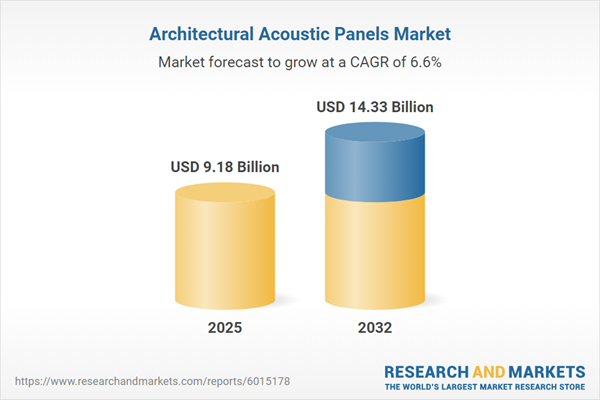Speak directly to the analyst to clarify any post sales queries you may have.
Architectural acoustic panels are central to creating adaptive, high-performance workplaces that align with compliance, occupant wellness, and evolving operational needs. For senior decision-makers, these solutions advance critical objectives by blending regulatory alignment with occupant comfort and productivity. Integration is now a priority for organizations seeking to future-proof workspaces amid changing demands.
Market Snapshot: Architectural Acoustic Panels Market
The architectural acoustic panels market is experiencing steady and robust growth, expanding in value from 2024 to 2025 and predicted to reach greater scale by 2032, propelled by a 6.55% compound annual growth rate. This sustained momentum reflects a convergence of urbanization, widespread adoption of open-plan workspaces, and stricter sustainability mandates. Project developers and facility leaders are increasingly specifying advanced acoustic panel systems to fulfill new environmental, wellness, and regulatory standards set by global and regional authorities. The market’s resilience and scale demonstrate its vital role in supporting flexible, compliant commercial environments and meeting shifting procurement and management expectations.
Scope & Segmentation: Core Market Landscape
- Application Areas: Panels provide noise reduction, precise sound diffusion, and visual adaptability for both new construction and retrofitting, serving commercial, institutional, and residential assets.
- Distribution Channels: Products are accessible through direct sales, specialty dealers, distributors, and manufacturer-led e-commerce channels, broadening reach to designers, contractors, and purchasing teams.
- Installation Types: Solutions include ceiling grid systems and direct wall or surface-mounted panels, supporting both early-stage projects and renovations.
- End Use Industries: Deployment extends across commercial offices, education, healthcare, industrial, and residential sectors, each demanding tailored acoustic and safety outcomes that guide procurement strategies.
- Material Types: Common construction materials are fiberglass, melamine foam, perforated metal, polyurethane foam, and wood wool. Selection is based on sustainability profiles, fire safety, and long-term durability.
- Geographic Coverage: The market spans the Americas, EMEA, and Asia-Pacific, with local regulations, design expectations, and compliance shaping supplier approaches and buyer priorities in each region.
- Company Coverage: Major suppliers such as Armstrong World Industries, Saint-Gobain, Knauf Gips, USG Corporation, ROCKWOOL International, Owens Corning, Hunter Douglas, CertainTeed, Ecophon, and Odenwald Faserplattenwerk offer broad product portfolios and collaborative options for large-scale projects.
Key Takeaways for Decision-Makers
- Adopting acoustic panels strengthens confidentiality and supports dynamic collaboration, making them indispensable for evolving office layouts and emerging hospitality concepts.
- Procurement teams embed sustainability by prioritizing bio-based foams and recycled composites, addressing rising standards in green building certification and organizational responsibility.
- Digital tools including virtual showrooms and rapid prototyping allow for seamless specification adjustments, facilitating bespoke system design and streamlined project timelines.
- Modular panel systems and multi-channel procurement models enable teams to swiftly align with shifting schedules, scope changes, and varied design requirements.
- Strategic local production combined with customized compliance processes empowers all stakeholders to navigate changes in raw material access and shifting regulatory environments with confidence.
Tariff Impact & Supply Chain Adaptation
Recent U.S. tariff changes affecting primary raw materials have initiated a marked shift in supply chain management for buyers and manufacturers. Emphasis is now on domestic sourcing and nearshoring strategies to minimize disruption, safeguard cost-control, and future-proof procurement. Enhanced transparency and ongoing specification refinements maintain supply chain resilience in an evolving regulatory and trade landscape.
Methodology & Data Sources
This analysis relies on direct inputs from architects, engineers, procurement executives, and distribution partners covering all key segments. Supplementary insights are derived from industry associations, compliance guidance, patent studies, and peer-reviewed research, equipping leadership teams with actionable, sector-specific recommendations.
Architectural Acoustic Panels Market: Why This Report Matters
- Enables decision-makers to align innovation, supply chain optimization, and regulatory strategies with shifting sustainability priorities and stakeholder expectations.
- Offers granular segmentation and targeted market intelligence to support precise procurement and productive supplier collaboration.
- Prepares organizations to respond proactively to supply chain and regulatory changes, maintaining operational momentum in uncertain market conditions.
Conclusion
Architectural acoustic panels are an essential component in future-ready workplaces, with organizations adapting to new standards and functional expectations. Decision-makers can rely on this analysis to guide sourcing, operational strategy, and compliance under rapidly evolving market dynamics.
Additional Product Information:
- Purchase of this report includes 1 year online access with quarterly updates.
- This report can be updated on request. Please contact our Customer Experience team using the Ask a Question widget on our website.
Table of Contents
3. Executive Summary
4. Market Overview
7. Cumulative Impact of Artificial Intelligence 2025
Companies Mentioned
The companies profiled in this Architectural Acoustic Panels market report include:- Armstrong World Industries, Inc.
- Saint-Gobain S.A.
- Knauf Gips KG
- USG Corporation
- ROCKWOOL International A/S
- Owens Corning
- Hunter Douglas N.V.
- CertainTeed Corporation
- Ecophon AB
- Odenwald Faserplattenwerk GmbH & Co. KG
Table Information
| Report Attribute | Details |
|---|---|
| No. of Pages | 188 |
| Published | November 2025 |
| Forecast Period | 2025 - 2032 |
| Estimated Market Value ( USD | $ 9.18 Billion |
| Forecasted Market Value ( USD | $ 14.33 Billion |
| Compound Annual Growth Rate | 6.5% |
| Regions Covered | Global |
| No. of Companies Mentioned | 11 |









